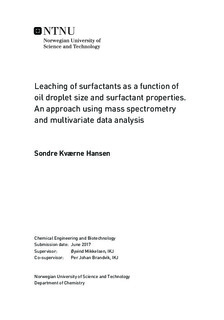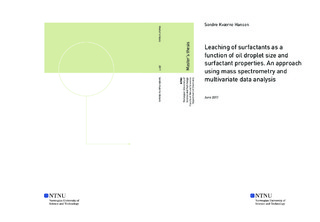| dc.description.abstract | Oil dispersants are used extensively in order to minimize the environmental damage that often follows an oil spill. A widely used dispersant, Corexit 9500A, consists of four surfactants with different properties and a solvent making sure that the interfacial tension between the oil and water is as low as possible. Low interfacial tension enhances natural dispersion of the oil. Due to the surfactant's different affinities to water and oil, individual leaching rates occur for the surfactants. This changes the relative composition, and thus decrease the efficiency of the dispersant. Experiments to determine these leaching rates have been conducted on oil slicks at the sea surface by Resby et al. (2007). Such rates are equally interesting subsurface, but have not been investigated.
By using SINTEF's Inverted Cone system, single oil droplets, treated with the dispersant Corexit 9500A, were captured and analyzed. The instrument used for analyses was a liquid chromatography-mass spectrometer. Direct injection of the samples into the electrospray ionization source was used to reduce unwanted effects due to the different chemical and physical properties of the surfactants. To extract information from the analyzed droplets, prediction models were built using partial least squares regression.
It was discovered that the relative composition of surfactants in a rising oil droplet changes over time. The total amount of surfactants was found to decrease to 63% of the initial mass after 15 minutes, and to 60% after 120 minutes. The relative concentration of the surfactants was found to mainly be determined during the first 15 minutes of contact time with seawater. The relative amount of the anionic surfactant, DOSS, was decreasing compared to the nonionic surfactants, Span 80, Tween 80 and Tween 85, before stabilizing.
It has been proven that the relative composition of the dispersant are changing while the oil droplet is rising towards the surface. This changed composition are affecting the dispersant effectiveness. | |

